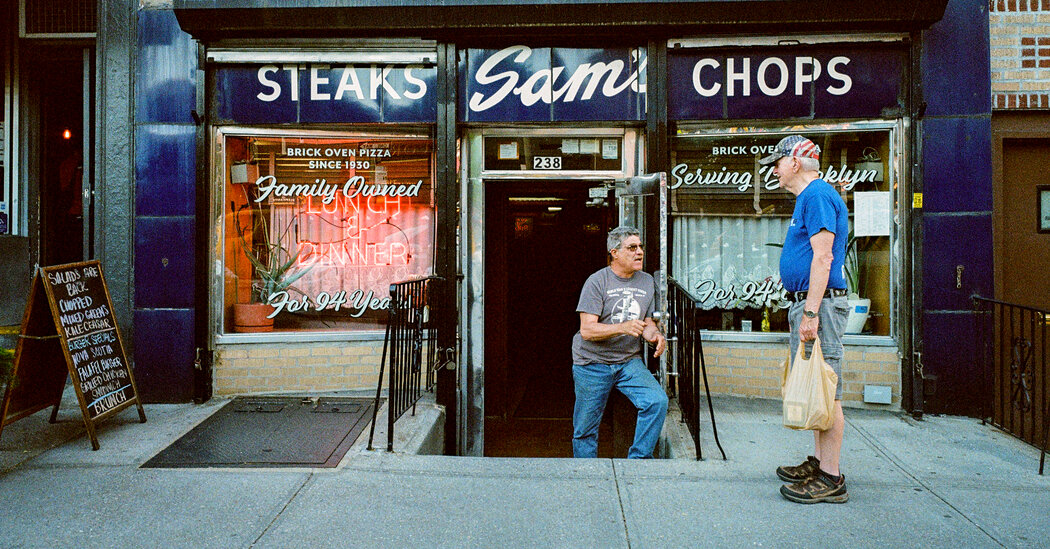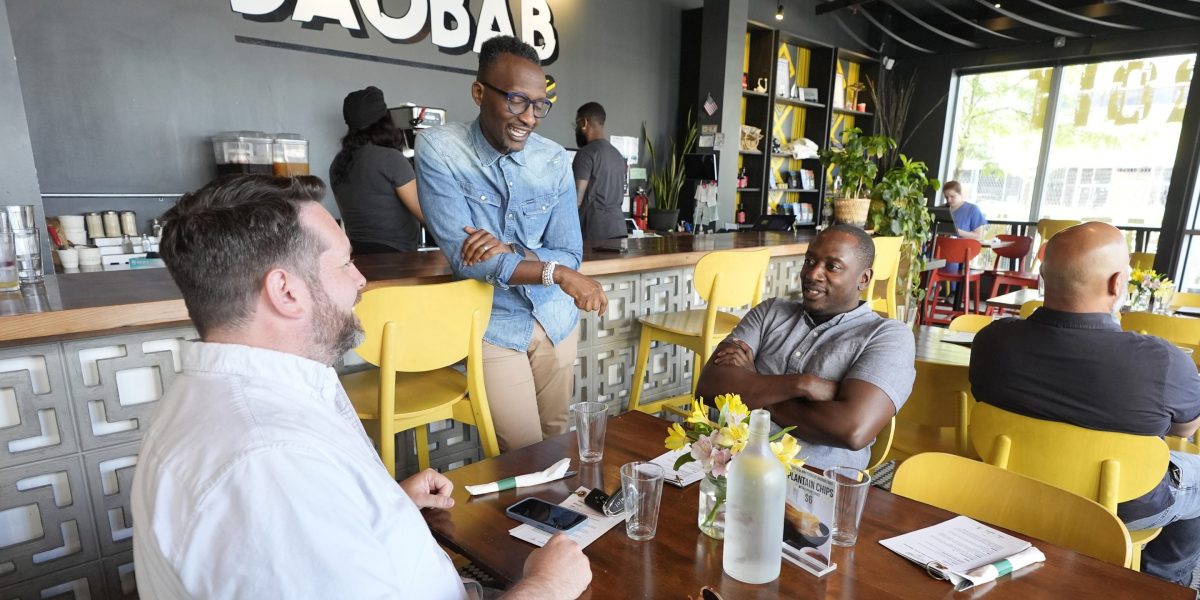Sam’s Restaurant, a 94-year-old red-sauce joint in Cobble Hill, Brooklyn, was uncharacteristically full of life. Serious-looking women in peacoats and laminated badges typed frantically on laptops. Carhartt-clad carpenters straightened picture frames and other period-appropriate props, all jangling carabiners and nervous energy. For the past week, dozens of people had been working to turn Sam’s into a believable replica of an Italian American social club during the Great Depression.
And even though this was the 59th time that a film crew had descended on Sam’s to turn it into an idealized version of its former self, this was also the biggest-budget production to ever do so. In fact, by half past 8 in the morning on that recent Friday, more people were inside the restaurant’s wood-paneled dining room than had been for a long time — perhaps since the actual 1930s.
The only person there with no obvious task was Louis Migliaccio. “I’m here to make things easy,” he said to an electrician who was standing on top of a ladder and trying to focus on removing a period-incorrect exit sign. “I can’t just sit here doing nothing.”
Although Mr. Migliaccio made it clear that he was not afraid to get his hands dirty, no one seemed to need his help. So instead, the 67-year-old did what he normally would as the proprietor of a restaurant that now practically seems to exist to play itself in movies: He headed outside for a smoke and a survey of the street.
Up came a white-haired couple in matching puffer jackets; they had lived in the neighborhood for decades. The man was gesticulating like a character from “The Sopranos,” clearly relishing the chance to pal around with his authentically Italian American neighbor. But Mr. Migliaccio was circumspect and did not mention the production happening inside, or that “The Bride!” would feature A-listers like Christian Bale and Penélope Cruz. He was being paid $85,000 for use of his restaurant, and he considered protecting the actors’ privacy part of the gig — kind of like an on-set omertà.
Just a few feet away from Mr. Migliaccio, extras with heavily contoured makeup and double-breasted pinstriped suits were lining up outside. The woman couldn’t help but notice them. She wanted to know: “Are you going to be in the picture, too, Louis?”
“I’m the boss,” he coolly replied. “I observe.”
It was only once the couple was out of earshot that the restaurateur launched into a lament: “Twenty years we’ve said ‘hi’ and this and that, but they’ve never come in to eat,” he said. “Not once.”
The escarole pizza at Sam’s has its devotees, and the restaurant offers a raft of pastas and dishes that center on clams and chops and chicken, which is referred to on the enormous laminated menu as “fowl.” There’s also Chianti, as well as Cokes that come in plastic bottles. Mr. Migliaccio keeps a secret stash of Manhattan Special, an old-school espresso soda, for himself.
All this makes Sam’s Restaurant an outlier in what was for most of the 20th century simply called South Brooklyn. There are any number of new rustic Italian places in the neighborhood and even more upscale brick-oven pizzerias. Celebrities like Jay-Z and Beyoncé regularly dine at Lucali, which has become so famous for both its calzones and its impossible-to-snag reservations that it was recently name-dropped on a track by the Pulitzer Prize-winning rapper Kendrick Lamar.
Sam’s attracts star power only on shoot day.
Just before 10:30 a.m., the film’s director, Maggie Gyllenhaal, arrived with a black baseball hat pulled down low over her face. She sidled up to Mr. Migliaccio on the sidewalk. “You’re the best,” she said before heading inside. “I was just telling everyone.”
In fact, Mr. Migliaccio is something of a known quantity in the New York entertainment world. He doesn’t have an IMDB page or a producers guild card, but thank-you notes from location scouts addressed to “Mr. Louis” hang on the walls of his restaurant, sandwiched between the long-defunct phone booths and his daughter’s college diploma. And while he doesn’t remember the first scout who discovered Sam’s, it probably happened in the 1970s, maybe a decade after his father took over the restaurant from his uncle.
There’s a reason the dates are fuzzy. Even though Mr. Migliaccio was born in the apartment above the restaurant, he was never especially keen on entering the family business and instead spent his 20s working at grocery stores and attending community college. He dreamed of joining the Navy and of ultimately becoming an architect, but he fell behind in drawing and quit school. “I didn’t have the brains for that,” he recalled. After dropping out, he worked for a while on Fulton Street nearby, in the toy section of a department store. He ended up a reluctant waiter at Sam’s around 1990.
By the time his father died and he took over, in 2016, the neighborhood where Mr. Migliaccio had grown up was no longer recognizable to him. The old Italians who lived in South Brooklyn were long gone, and the rents were now among the most expensive in the city. The area was full of the kind of restaurants that he describes as having a guy whose entire job it is to refill your water. What’s worse, the new people coming to Sam’s demanded the same kind of over-the-top service from him. “People expect you to kiss their ass,” he says. “But why do I gotta make it so dramatic when it’s a family restaurant?”
It wasn’t so long ago that the roughness around the edges was part of the appeal of a place like Sam’s. But it was clear to Mr. Migliaccio that the newest Brooklynites had little interest in what came before. He felt like an alien standing behind these people at the local butcher, as they’d commit the unforgivable sin of asking for a couple tiny slices of meat — an order barely worth the butcher’s time to cut. “The people who started moving in didn’t care about the old stores,” Mr. Migliaccio said. “They were not interested in helping us.”
Thankfully, there was one Sam’s regular interested in helping Mr. Migliaccio. She had a job scouting locations for magazine photo shoots and taught him a handful of rudimentary lessons, like never accept a first offer from a scout and always get an insurance contract before production begins. It was a blessing, but it landed him in something like purgatory.
Playing itself in the movies is now the only thing that keeps Sam’s Restaurant afloat.
Michael Hartel, a location manager who has been in the business for 25 years, doesn’t remember how Sam’s first got on his radar, but he’s shot there twice for the network procedural “FBI” — one scene in which a mobster meets with some undercover agents, and another in which criminals hold a backroom card game. Mr. Hartel says that basically everyone in his corner of the universe has worked with Mr. Migliaccio.
Sure, there are other good filming locations in the city: The production-friendly bar Capri Social Club in Greenpoint and the pizza spot John’s of Bleecker Street still scream “New York.” But Mr. Hartel says the portfolio of reliable spots has thinned over the past decade, and that these days it’s often a florist or a soda fountain in New Jersey that stands in for one in Brooklyn.
“Trying to find a dining establishment with the red vinyl booths that looks old-school is so much harder than it used to be,” Mr. Hartel said. “Everything here looks like a Pottery Barn now.”
For that reason, Sam’s is beloved among casting directors, though Mr. Hartel notes that there is something a bit odd about the place.
Both times after wrapping on “FBI,” Mr. Hartel wanted to come back and try the escarole pizza. But he couldn’t get a straight answer from Mr. Migliaccio about when the place was open — he couldn’t say when it would stop being a movie set and serve food again.
“He’s such a nice guy, but I have no idea how he sustains,” Mr. Hartel said. “It’s almost like Louis is not really running a restaurant anymore.”
But he is. A week after the film crew for “The Bride!” had cleared out and restored the plastic flowers and thank-you notes from location scouts, those photogenic red vinyl booths at Sam’s were full, mostly, it seemed, with tourists and young New York transplants. Mr. Migliaccio was giving them dinner and a show, playing up the part of the frazzled and gruff New Yorker — though as the only waiter in the place, he was legitimately overworked.
A family with a young son was not making things any easier for him. The boy, who appeared to be about 2, was running amok, climbing on the bar and stomping on Mr. Migliaccio’s toes. The boy’s mother, who was wearing a Dodgers hat, looked on indulgently until Mr. Migliaccio hoisted the kid up and pretended to discipline him. The boy giggled and his mother let out a muffled gasp.
“I’m gonna put you to work in the back!” he threatened in jest. “I’m not gonna let you leave!”
A group of young women sipping martinis and sharing a plate of calamari clapped in delight. This scene — a service professional who doesn’t know you can’t raise your voice, never mind threaten to kidnap a customer’s child — is what they came to Brooklyn to see. This is why they came to Sam’s.
By 8:30, Mr. Migliaccio had kicked everyone out and closed the kitchen. He sat by the door, poring over a large black ledger. His family has owned the building for years, so he doesn’t pay rent, but he used his own savings to keep the place open during the coronavirus pandemic, which means he’s in debt to himself.
And the bills never stop coming: the liquor guys, the refrigerator repairman, the payroll for the chefs. On top of everything else, the exterminator was set to arrive by the following week. “I’d be better off blowing up the place with a stick of dynamite,” he said.
His dream is to retire and leave all the annoyances behind. But it’s complicated. He claims that he doesn’t want to give his new neighbors the satisfaction, but in reality he has no one to take over the place; his daughter is pursuing a career in law enforcement.
A real estate agent once told him he could charge an enormous sum in rent to a new tenant — tens of thousands of dollars a month. But what kind of person could afford to pay that? Sometimes, he said, he wished he’d just go under — get it over with already. The ability to rent the restaurant out for movie productions was as much a curse as it was a blessing. He had three more shoots lined up already, so he was chained to the place until at least the end of the year.
But that money may come to an end soon. Anachronisms in the background of shots can now be digitally erased. That means there may no longer be much need for a place that is perfectly stuck in time; when you can edit out air-conditioners, security cameras, ice machines and other trappings of modern life in postproduction, you can shoot pretty much anywhere. But for now, Sam’s was the place to be, and shoot days gave Mr. Migliaccio a chance to come alive.
Back on set, he’d been relegated to a spot near the kitchen behind a bank of monitors. For a while, he stayed there, browsing Facebook on his phone and texting with cousins in Italy. But he couldn’t help wondering what the actors were doing inside the place he’d spent practically his entire life. Every half minute or so, he scooted a metal folding chair closer and closer to the men with the monitors, until he was standing with his nose practically touching one of the screens.
Eventually, even that wasn’t enough. Mr. Migliaccio ducked out through a side door and used a back alley to enter the kitchen of a neighboring restaurant. Then he burst through the front door of Sam’s, interrupting the movie.
“You can’t be in here!” an exasperated young assistant in an earpiece wailed. Mr. Migliaccio gave him a withering look. Everyone in Sam’s — the editors at the monitors, the character actors who had responded to a casting call for God knows what description, even Ms. Gyllenhaal herself — would have to wait patiently as the real boss of the place took a Manhattan Special from the fridge under his bar.
“The kitchen to me is boring,” he said later on the sidewalk after filming resumed. “It’s the same four walls. But out there, on shoot day, that’s where I can have a little fun.”















